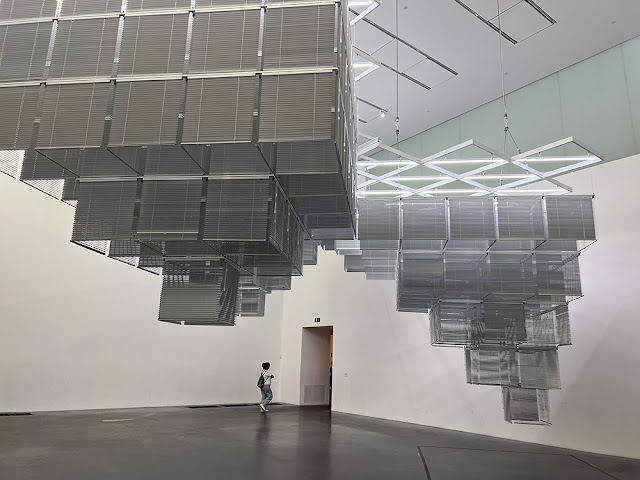TATE MODERN
Bankside, London SE1 9TG
Our mission is to increase the public’s enjoyment and understanding of British art from the 16th century to the present day and of international modern and contemporary art.
If you find yourself in London and you're a fan of modern art, you should take the time to visit the Tate. You probably won't be able to see everything on the same day, but you will have fun trying.
The former Bankside Power Station was selected as the new gallery site in 1994. The following year, Swiss architects Herzog & De Meuron were appointed to convert the building into a gallery. That their proposal retained much of the original character of the building was a key factor in this decision.
The iconic power station, built in two phases between 1947 and 1963, was designed by Sir Giles Gilbert Scott.
The building consisted of a stunning turbine hall, 35 meters high and 152 meters long, with the boiler house alongside it and a single central chimney. However, apart from a remaining operational London Electricity sub-station, the site had been redundant since 1981.
In 1996 the design plans were unveiled and, following a £12 million grant from the English Partnerships regeneration agency, the site was purchased and work began. The huge machinery was removed and the building was stripped back to its original steel structure and brickwork. The turbine hall became a dramatic entrance and display area and the boiler house became the galleries.
How can art be used to disrupt and challenge patriarchal systems?
In Bosnian Girl artist Šejla Kamerić stares directly at the camera, holding our gaze. The overlaid text quotes graffiti by an unknown Dutch UN soldier found at an army barracks in Srebrenica during the Bosnian war (1992–95). Using the stylized poses found in fashion photography, Kamerić both challenges and embodies the soldier’s words. In this act, she stands for all women who have experienced prejudice because of their gender or identity. She hints at how women become markers of national identity, their bodies politicized as a way to uphold territories and borders. In her gaze, she asks us as viewers to be accountable for our own ways of looking.
GUERRILLA GIRLS
This display shows the work of the anonymous feminist collective that uses daring text and phrases to expose injustice in art and beyond.
The Guerrilla Girls are an activist group made up of women artists and art professionals. They formed in 1985, in response to an exhibition at the Museum of Modern Art in New York which featured only 13 women out of 169 artists. Under the cover of darkness, they fly-posted SoHo street corners, declaring statistics that exposed gender-based discrimination in museums and art galleries. They hide their identities behind gorilla masks and have adopted pseudonyms of celebrated dead women artists and writers such as Kathë Kollwitz, Frida Kahlo, and Gertrude Stein.
Today, the group continues to reveal the racism, sexism, and homophobia prevalent in art and society. They are most well-known for text-based posters that drip with wit and sarcasm, holding Euro-American institutions accountable for their actions. This dry sense of humor in backgrounds of pop pinks and yellows contrasts with the harrowing story of inequality being told. By using straightforward data and rhetorical questions, the facts speak for themselves.
MATERIALS AND OBJECTS
The Materials and Objects display looks at the inventive ways in which artists around the world use diverse materials.
The work of Haegue Yang explores the history of conceptual art as shaped by a set of rules.
Haegue Yang often makes work using everyday domestic items, transforming them in extraordinary ways. This suspended sculpture is made of over 500 Venetian blinds. Yang’s choice highlights the unique sculptural possibilities of these ordinary window coverings. They can be flat, three-dimensional, opaque, transparent, compressed, or expanded.
How does Yto Barrada explore themes of power and strategies of resistance through natural and urban landscapes?
Barrada uses many kinds of materials to make her work: photography, film, sculpture, printing, textiles, and installation. Her artworks focus on Morocco, in particular her hometown of Tangier, which she has researched in depth. She also founded Morocco’s first cinema cultural center, the Cinémathèque de Tanger.
Thamesmead Codex celebrates the voices and local community of Thamesmead, London
From 2019–2020, artist Bob and Roberta Smith interviewed people who live in Thamesmead, southeast London. Built in 1968 to alleviate London’s housing shortage, Thamesmead was one of many modernist large-scale housing projects constructed across Europe after the Second World War. Smith talked to a number of local residents, from some of its very first occupants to young people growing up during the Covid-19 pandemic. He then turned their conversations into the 24 painted placards you can see here. Reflecting on the work, Smith said ‘I thought I was making a painting about a housing estate, but actually I’ve been painting about the desire to be heard.’
These are just some of the notable exhibits on this day, covering many different themes and creative processes. And, kudos to my beautiful wife for making this trip happen.
















